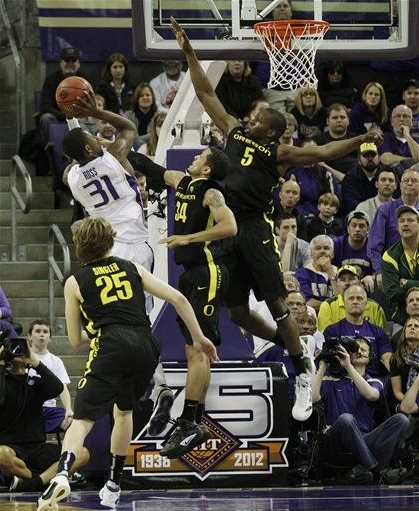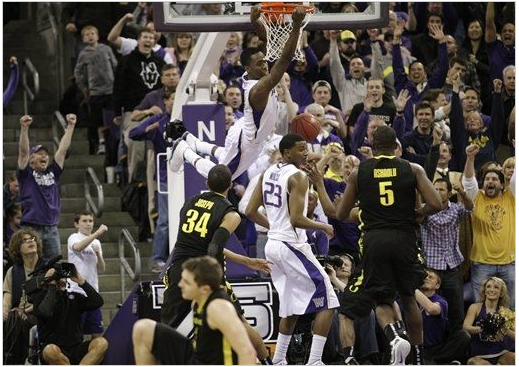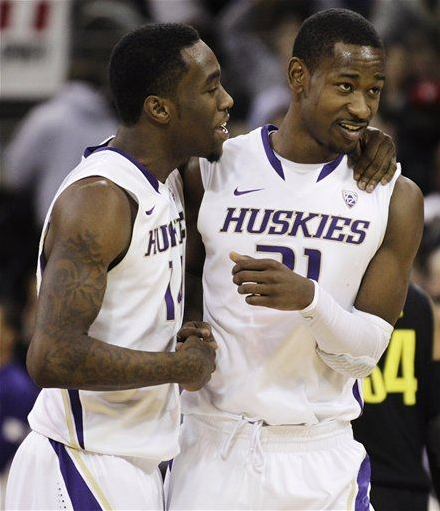Draft Profile: Terrence Ross and Tony Wroten
2012-04-02At times during this season, I occasionally thought the draft profiles weren’t the most appropriate content for the Blog. With Kyrie’s star rising and Varejao dominating; I asked “should more focus be placed on the present?” Those sentiments are squashed; it looks like time for both eyes to look squarely at the draft.
The Cavs roster requires bolstering…badly; the need to nail both first round picks looms large. The University of Washington recently reached the NIT final four behind two underclassmen guards: Terrence Ross and Tony Wroten. Both projected in the draft’s 18 – 22 range, if the Cavs make a trade or the Lakers’ draft position rises, the Cavs could be interested.
Standing 6’7″ and possessing a quick first step and quality leaping ability, Ross provides an immediate upgrade over the current crop of Cavs twos. Primarily a jump shooter, the sophomore also utilizes his athleticism to score in transition and making strong cuts to the basket in the half -court. With a quick shooting release, he’s improving his jumper off the dribble and squaring up around a screen. This season, he made 52% of his two-point field goals and 37% from long distance. His size, athleticism and on-court drive provide for solid defense, and of 83 shooting guards available in draftexpress.com’s database, he ranks 3rd in pace adjusted defensive rebounds per minute. He won’t be a 20 point per game scorer, but combining his athleticism, shooting and effort should find him in an NBA rotation for several years to come.
For a ceiling, Wroten has been compared to Tyreke Evans. A 6’6″, strong & speedy freshman that just turned 19 in April, he works best as an isolation scorer. He aggressively attacks the basket using his dominant left hand, possessing a vast array of ball handling and change of pace maneuvers. To some extent, his physique and frequent forays into the paint represent the extent of his strengths though. He made 16% of his three pointers and 58% of his free throws; unfortunate considering that his drives result in a lot of attempts. In addition to occasional bouts of poor shot selection, he does not take care of the ball, averaging nearly four turnovers per game.
For a further look at these players strengths and weaknesses, let’s check out some game notes.
March 20th against Oregon
In this 90 to 86 Washington victory, Ross contributed to the high scoring with 24 points on 62% true shooting. Of his 18 shots, 12 were jumpers, and he was much more effective as a catch and shoot player than off the dribble. Using 9 possessions resulted in 16 points when spotted up, off screens, or from the post. Scoring off the bounce did not provide good results; Ross ended with 4 points on 7 shots in isolation, combining drives and pull-up jumpers. Despite continuing to develop this aspect of his game, I think the results of this day are consistent with his overall performance.
Wroten finished with 22 points, 7 rebounds & 2 assists behind 52% true shooting. His playmaking style resulted in fourteen trips to the charity stripe, of which he made ten. His driving abilities were on full display, including an array of quick first strides, nifty behind-the-back dribbles, tight spins, and controlled hop-steps to get into the paint, finishing strong through contact and flashing some fancy no-look passes. Unfortunately, his poor marksmanship reared it’s ugly head, highlighted through two horribly missed jumpers (one air ball). Towards the end of the second half, OU played at least 6 feet off him, daring him to shoot.
Regarding defense, Ross and Wroten weren’t largely responsible for Oregon’s offensive onslaught. Oregon’s players 6’7″ and taller beat up on Washington’s interior players, finishing 16 of 25 from the field for half of the Ducks points. While both players made defensive miscues, the Oregon frontline dominance was not based on dribble penetration, but instead on the OU big men establishing deep post position or grabbing offensive rebounds. Oregon’s players shorter than 6’7″ netted the team’s other 43 points by shooting 15 of 44. Ross exhibited solid perimeter fundamentals and Wroten’s length and quick hands were frequently disruptive.
March 27th against Minnesota
In this tight NIT semifinal overtime loss, Ross put in 21 points on 51% true shooting alongside 6 rebounds. His pull-up jumper was much more effective, providing a respectable 8 points in 7 possessions used. Utilizing an arsenal of post moves including hook shots, turnarounds and step-thrus, he posted his second consecutive effective game in this area. As a 6’7″ shooting guard, this should be an area to also use advantageously in the NBA. Downsides included ball protection; he’s an adequate ball handler, but travelled twice, got lazy and had the ball poked away on another play, and threw one poorly conceived alley-oop. He continued to move well and get low on defense and was menacing in the passing lanes, tallying 3 steals and several tipped passes. Unfortunately though, he also tended to stray too far from his man; resulting in frequent issues effectively closing out on a jump shooter.
Wroten won’t list this tilt high on his resume, as he finished with 9 points on 16 shots, with 0 assists. The game was held at Madison Square Garden; perhaps Wroten chose not to sleep in the city that never sleeps. I counted six first half possessions where a defensive mistake resulted in a Gopher layup or dunk. Following a matador-like possession with 2:25 to go, he found his way to the bench, where he stayed until five minutes into the second half. Later, following back-to-back possessions of wild shots, he sat again, this time during six critical minutes of the game. After re-entering with less than three minutes on the clock, he made a bone-headed play with 30 seconds left in regulation and Washington trailing 59 – 57, by fouling the ball-handler 25 feet from the basket after the Gophers had run the shot clock down. The prevalence of his dominant left hand was also apparent; on seven drives where I made note of the direction he started, six went left. On one attempted finish from the right side, he brought the ball back to his left hand, directly towards the defender, resulting in an immensely more difficult shot. In isolation, he had almost no success finishing, as only one of his four field goals came this way. The other three were via transition, an alley-oop finish, and an offensive rebound. Overall, this was just not an appealing performance. He did grab three steals, using remarkably quick hands to snatch opponent’s dribbles.
Summary: Based on an early look at the likely available players, I would feel pretty good about Cleveland picking Ross around 20. He helps address the need for increased athleticism on the wing and should fill it up on the receiving end of Kyrie’s drive & kicks. Statsheet.com tracks college plus / minus data for most games; in the games recorded there, the Huskies are +161 when Ross plays, but -21 when he sits. That’s an encouraging snippet into the all around value Ross can bring. Wroten on the other hand nets a +107 on-court, compared to +35 when he rides the pine. He did just turn 19 though and is a freight train barreling into the lane. Given the Cavs’ needs, Ross certainly rates above Wroten, and that is fine with me.




John, I don’t think they trade Varajao for a lottery pick straight up. I could see the Cavs including Varajao and the 7-8 pick to go up to 4 or 5 and get Matthews back though. Also, no guarantee that New Jersey doesn’t get one of the top 3 picks and make the point moot, but if they get the pick, Portland will have a lot of control on over the lottery.
HoopsDogg,
Also he’s a Canadian big man. The Cavs could have a theme going there.
I haven’t looked into Nicholson too much, but I will (I’ve got a system), but he should definitely be on the Cavs radar with their three picks between 25 – 35.
I know this was a highly debated topic earlier this season, but the acquisition of the Nets top 3 protected pick by Portland pits them as exactly the type of team (and really, the only team for the forseeable near future) that would be a potential suitor for Anderson Varejao before the draft. Obviously pending the actual order of standings and lottery draw, the Blazers could realistically hold 2 top 13 picks AND have a need for a C to pair with a scoring big in Aldridge AND be a team already on the cusp of playoff contention. I suppose… Read more »
http://www.draftexpress.com/profile/Andrew-Nicholson-5518/ Statistically, more than Moultrie, I see Nicholson as one of the big sleepers in this draft: a polished scorer with range out to the three point line, big wingspan, big hands, and is a decent shotblocker. He’s a big I wouldn’t mind seeing get taken with our Lakers pick, or our 2nd round pick. Good skills and lots of upside for a senior.
Yeah, Moultrie is a terrible defender. The one time I watched him in person, he got torched by the one dimensional Erik Murphy. I see him being a Cavs’ era Antawn Jamison; stretch 4, volume shooter, poor defense and overall just a very average player that will be overrated because he can score.
Chris, When I’ve watched Moultrie, he appeared to be a really poor defender. With the Laker’s pick (or through an associated trade), I prefer Ross, Jeff Taylor or Dion Waiters. I’d actually be fine with the Cavs trading one pick in order to improve another and with the three picks they still had, drafting 3 wings, if that is who they thought were the three players available who were most likely to be solid contributing pros. Doron Lamb and Darius Miller could be targets early in the second round. The wing rotation next year would be Gee and 3 rookies.… Read more »
Scuzz, Obviously we don’t know if the Cavs will have the chance to draft Beal first. Even if they did, I’m not completely concerned with Ross being redundant. The Cavs need a lot of help at the wing; they shouldn’t get too torn up about what position a player plays (i.e 2 or 3). Find a way to acquire the players they like best; keep it that simple. Plus, Ross is 6’7″. A Beal, Ross, Gee rotation would be small at the 2 & 3 in the short term, but top priority is getting some players. If you choose the… Read more »
What about Arnett Moultrie with the Lakers’ pick? nbadraft.net has him at 11, I think (which is ridiculous because they also have Beal at 8), but ESPN and draftexpress.com list him around 25-30. He’s a 6’11”, 230 lb PF or C (probably center) who can rebound and has a good offensive game.
However, if they pick Beal first, taking Ross would be redundant.
Take Beal with the first pick
Moe Harkless, Quincy Miller, or Jeff Taylor with the Lakers pick
Fab Melo or Festus Ezeli with the top second rounder (or package them to move up if necessary)
I agree with everyone indicating that Ross won’t be there at #25. If the Cavs really like him though and the Lakers pick improves a little, perhaps the Cavs could package one of the two high second round picks and move up.
I like Ross, but he won’t be around for the Lakers pick. As far as centers go, I would be fine with Melo or Ezeli, but would lean towards Ezeli due to Melo’s academic issues. Ezeli won’t be anything over a decent starter, but could fill a similar role as Brendan Haywood. Both are true centers with plenty of strength, little offense, pretty good defense and above average potential despite staying all 4 years in college.
Oh, yeah, and I want Beal.
Ross is my favorite player in the draft after Beal. I thinks he fits so perfectly here that I wouldn’t mind getting him if our picks falls back to 7-9.
I’ve been a huge Ross fan all year and was almost hoping the Cavs would win enough games to fall to an area that they could pick him and maybe get the steal of the draft. With the Cavs moving up the lottery ladder I’m thinking they might be picking too early to warrant taking him and that the Laker pick will be too late. I’m betting he moves up in the draft as TO’s happen and peole look at him closer. Ross satisfies the Cavs biggest need, which I see to be a true SG with decent length. I… Read more »
I like Ross, he reminds me of a young Anthony Parker (this is actually a good thing). Not necessarily a star, but should be a very good player for several years. May age into ‘just’ a spot up shooter, but in the meantime can adequately score in a variety of ways. There are several C’s this year worth picking up. Drummond is the favorite, but anytime the word ‘raw’ is used to describe a player in the lottery, what I hear is ‘bust’. Drummond hasn’t performed this year but has an NBA ready body, as far as I can tell,… Read more »
I think Terrence Ross is under rated and will move up draft boards before the day arrives. That makes me very sad because he is exactly the player I would like to see us take with that second pick. Chances are MKG and Beal will be gone by our pick, and we will face a few options: Take a big man – Zeller, Drummond, hope Barnes can live up to the hype, or draft Jery Lamb earlier than need be. I would like to see us package a couple of our picks and move up with that second pick if… Read more »
Fab Melo would likely be available when the Cavs select in round two. I wouldn’t mind if they picked either him or Festus Ezeli with their top second round pick. Both of those 2nd rounders could be in the top 5. That could bode well for Cleveland if the top prospects continue to declare. Although I wonder how possible it would be to package those two picks and move up with the Lakers pick.
If the Cavs are able to grab one of the top tier wings with their first pick, I think Fab Melo would be great choice with the Laker’s pick. He’s raw offensively, but would fill the hole the Cavs have at the center position (I personally prefer to see Varejao play the 4 with TT as a sixth man bringing his energy/shot blocking off the bench). Melo’s biggest weakness aside from his post offense is a lack of consistant effort. What better situation for him than alongside a fellow Brazilian known for hustle and passion for the game? Andy would… Read more »
Glad you covered Terrence Ross, I’ve been high on him for the past few weeks. If the Cavs don’t address SG with our first pick, I would definitely be an advocate for taking Ross, even if it requires trading up a few spots.
This is all I’ve wanted from the Cavs all season. Tank you.